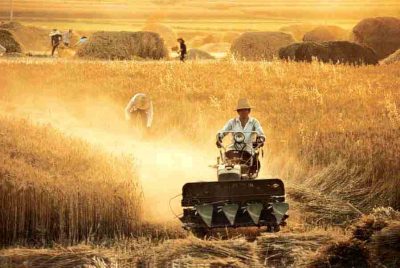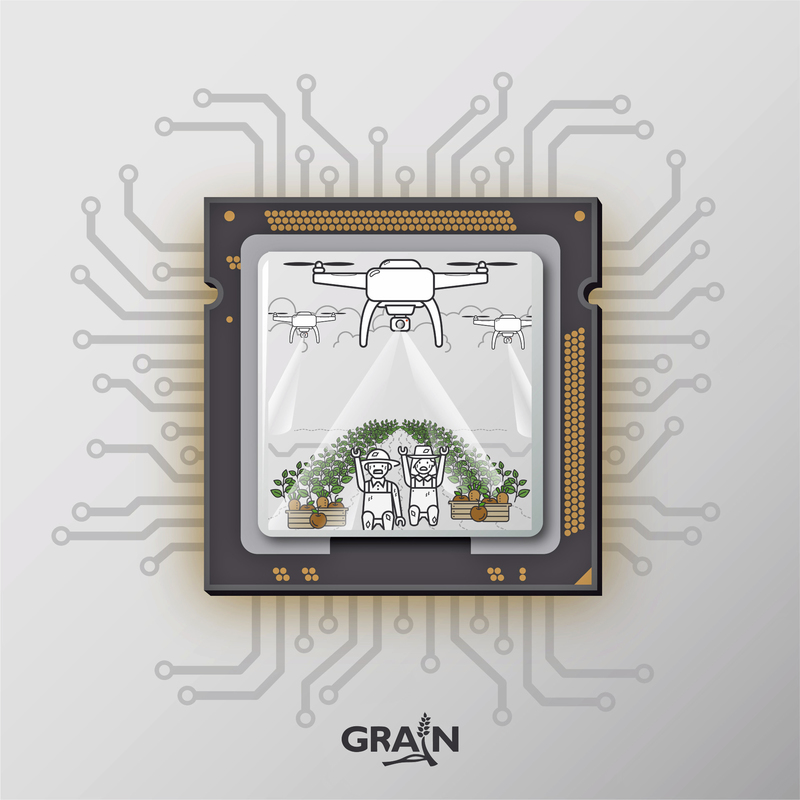
“A total demolition of the previous forms of existence is underway: how one comes into the world, biological sex, education, relationships, the family, even the diet that is about to become synthetic.” — Silvia Guerini, radical ecologist, in ‘From the ‘Neutral’ Body to the Posthuman Cyborg: A Critique of Gender Ideology’ (2023)
We are currently seeing an acceleration of the corporate consolidation of the entire global agri-food chain. The big data conglomerates, including Amazon, Microsoft, Facebook and Google, have joined traditional agribusiness giants, such as Corteva, Bayer, Cargill and Syngenta, in a quest to impose their model of food and agriculture on the world. [1]
Image source

The Bill and Melinda Gates Foundation and big financial institutions, like BlackRock and Vanguard, are also involved, whether through buying up huge tracts of farmland, pushing biosynthetic (fake) food and genetic engineering technologies or more generally facilitating and financing the aims of the mega agri-food corporations. [2]
The billionaire interests behind this try to portray their techno-solutionism as some kind of humanitarian endeavour: saving the planet with ‘climate-friendly solutions’, ‘helping farmers’ or ‘feeding the world’. But what it really amounts to is repackaging and greenwashing the dispossessive strategies of imperialism.
It involves a shift towards a ‘one world agriculture’ under the control of agritech and the data giants, which is to be based on genetically engineered seeds, laboratory created products that resemble food, ‘precision’ and ‘data-driven’ agriculture and farming without farmers, with the entire agrifood chain, from field (or lab) to retail, being governed by monopolistic e-commerce platforms determined by artificial intelligence systems and algorithms.
Those who are pushing this agenda have a vision not only for farmers but also for humanity in general.
The elites through their military-digital-financial (Pentagon/Silicon Valley/Big Finance) complex want to use their technologies to reshape the world and redefine what it means to be human. They regard humans, their cultures and their practices, like nature itself, as a problem and deficient.
Farmers are to be displaced and replaced with drones, machines and cloud-based computing. Food is to be redefined and people are to be fed synthetic, genetically engineered products. Cultures are to be eradicated, and humanity is to be fully urbanised, subservient and disconnected from the natural world.
What it means to be human is to be radically transformed. But what has it meant to be human until now or at least prior to the (relatively recent) Industrial Revolution and associated mass urbanisation?
To answer this question, we need to discuss our connection to nature and what most of humanity was involved in prior to industrialisation — cultivating food.
Many of the ancient rituals and celebrations of our forebears were built around stories, myths and rituals that helped them come to terms with some of the most fundamental issues of existence, from death to rebirth and fertility. These culturally embedded beliefs and practices served to sanctify their practical relationship with nature and its role in sustaining human life.
As agriculture became key to human survival, the planting and harvesting of crops and other seasonal activities associated with food production were central to these customs.
Humans celebrated nature and the life it gave birth to. Ancient beliefs and rituals were imbued with hope and renewal and people had a necessary and immediate relationship with the sun, seeds, animals, wind, fire, soil and rain and the changing seasons that nourished and brought life. Our cultural and social relationships with agrarian production and associated deities had a sound practical base.
People’s lives have been tied to planting, harvesting, seeds, soil and the seasons for thousands of years.
Silvia Guerini, whose quote introduces this article, notes the importance of deep-rooted relationships and the rituals that re-affirm them. She says that through rituals a community recognises itself and its place in the world. They create the spirit of a rooted community by contributing to rooting and making a single existence endure in a time, in a territory, in a community.
Professor Robert W Nicholls explains that the cults of Woden and Thor were superimposed on far older and better-rooted beliefs related to the sun and the earth, the crops and the animals and the rotation of the seasons between the light and warmth of summer and the cold and dark of winter.
Humanity’s relationship with farming and food and our connections to land, nature and community has for millennia defined what it means to be human.
Take India, for example. Environmental scientist Viva Kermani says that Hinduism is the world’s largest nature-based religion that:
“… recognises and seeks the Divine in nature and acknowledges everything as sacred. It views the earth as our Mother and hence advocates that it should not be exploited. A loss of this understanding that earth is our mother, or rather a deliberate ignorance of this, has resulted in the abuse and the exploitation of the earth and its resources.”
Kermani notes that ancient scriptures instructed people that the animals and plants found in India are sacred and, therefore, all aspects of nature are to be revered. She adds that this understanding of and reverence towards the environment is common to all Indic religious and spiritual systems: Hinduism, Buddhism and Jainism.
According to Kermani, the Vedic deities have deep symbolism and many layers of existence. One such association is with ecology. Surya is associated with the sun, the source of heat and light that nourishes everyone; Indra is associated with rain, crops, and abundance; and Agni is the deity of fire and transformation and controls all changes.
She notes that the Vrikshayurveda, an ancient Sanskrit text on the science of plants and trees, contains details about soil conservation, planting, sowing, treatment, propagating, how to deal with pests and diseases and a lot more.
Like Nicholls, Kermani provides insight into some of the profound cultural, philosophical and practical aspects of humanity’s connection to nature and food production.
This connection resonates with agrarianism, a philosophy based on cooperative labour and fellowship, which stands in stark contrast to the values and impacts of urban life, capitalism and technology that are seen as detrimental to independence and dignity. Agrarianism, too, emphasises a spiritual dimension as well as the value of rural society, small farms, widespread property ownership and political decentralisation.
The prominent proponent of agrarianism Wedell Berry says:
“The revolution which began with machines and chemicals now continues with automation, computers and biotechnology.”
For Berry, agrarianism is not a sentimental longing for a time past. Colonial attitudes, domestic, foreign and now global, have resisted true agrarianism almost from the beginning — there has never been fully sustainable, stable, locally adapted, land-based economies.
However, Berry provides many examples of small (and larger) farms that have similar output as industrial agriculture with one third of the energy.
In his poem ‘A Spiritual Journey’, Berry writes the following:
“And the world cannot be discovered by a journey of miles,
no matter how long,
but only by a spiritual journey,
a journey of one inch,
very arduous and humbling and joyful,
by which we arrive at the ground at our feet,
and learn to be at home.”
But in the cold, centralised, technocratic dystopia that is planned, humanity’s spiritual connection to the countryside, food and agrarian production are to be cast into the dustbin of history.
Silvia Guerini says [3]:
“The past becomes something to be erased in order to break the thread that binds us to a history, to a tradition, to a belonging, for the transition towards a new uprooted humanity, without past, without memory… a new humanity dehumanised in its essence, totally in the hands of the manipulators of reality and truth”.
This dehumanised humanity severed from the past is part of the wider agenda of transhumanism. For instance, we are not just seeing a push towards a world without farmers and everything that has connected us to the soil but, according to Guerini, also a world without mothers.
She argues that those behind test-tube babies and surrogate motherhood now have their sights on genetic engineering and artificial wombs, which would cut women out of the reproductive process. Guerini predicts that artificial wombs could eventually be demanded, or rather marketed, as a right for everyone, including transgender people. It is interesting that the language around pregnancy is already contested with the omission of ‘women’ from statements like ‘persons who can get pregnant’.
Of course, there has long been a blurring of lines between biotechnology, eugenics and genetic engineering. Genetically engineered crops, gene drives and gene editing are now a reality, but the ultimate goal is marrying artificial intelligence, bionanotechnology and genetic engineering to produce the one-world transhuman.
This is being pushed by powerful interests, who, according to Guerini, are using a rainbow, transgenic left and LGBTQ+ organisations to promote a new synthetic identity and claim to new rights. She says this is an attack on life, on nature, on “what is born, as opposed to artificial” and adds that all ties to the real, natural world must be severed.
It is interesting that in its report Future of Food, the UK supermarket giant Sainsburys celebrates a future where we are microchipped and tracked and neural laces have the potential to see all of our genetic, health and situational data recorded, stored and analysed by algorithms that could work out exactly what food (delivered by drone) we need to support us at a particular time in our life. All sold as ‘personal optimisation’.
Moreover, it is likely, according to the report, that we will be getting key nutrients through implants. Part of these nutrients will come in the form of lab-grown food and insects.
A neural lace is an ultra-thin mesh that can be implanted in the skull, forming a collection of electrodes capable of monitoring brain function. It creates an interface between the brain and the machine.
Sainsburys does a pretty good job of trying to promote a dystopian future where AI has taken your job, but, according to the report, you have lots of time to celebrate the wonderful, warped world of ‘food culture’ created by the supermarket and your digital overlords.
Technofeudalism meets transhumanism — all for your convenience, of course.
But none of this will happen overnight. And whether the technology will deliver remains to be seen. Those who are promoting this brave new world might have overplayed their hand but will spend the following decades trying to drive their vision forward.
But arrogance is their Achilles heel.
There is still time to educate, to organise, to resist and to agitate against this hubris, not least by challenging the industrial food giants and the system that sustains them and by advocating for and creating grass-root food movements and local economies that strengthen food sovereignty.
*
Click the share button below to email/forward this article to your friends and colleagues. Follow us on Instagram and Twitter and subscribe to our Telegram Channel. Feel free to repost and share widely Global Research articles.
One Month Before Global Research’s Anniversary
Renowned author Colin Todhunter specialises in development, food and agriculture. He is a Research Associate of the Centre for Research on Globalization (CRG).
Notes
[1] See Food, Dispossession and Dependency: Resisting the New World Order.
[2] See Sickening Profits: The Global Food System’s Poisoned Food and Toxic Wealth
[3] A debt of gratitude is owed to Paul Cudenec and his article Truth, reality, tradition and freedom: our resistance to the great uprooting on the Winter Oak website, which provides quotes from and insight into the work of Silvia Guerini.














